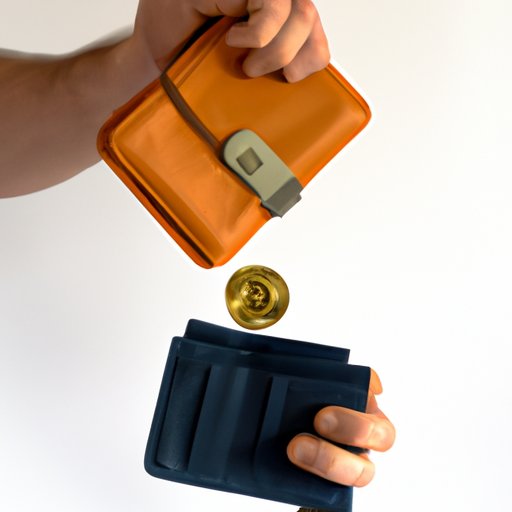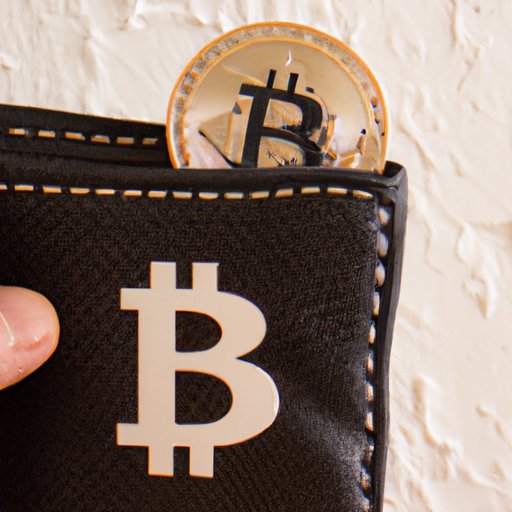Introduction
Bitcoin is a form of digital currency that is becoming increasingly popular due to its ability to be sent and received quickly and securely. Sending and receiving bitcoins is easier than ever, but it can be intimidating for those who are new to the concept. This article will provide a step-by-step guide on how to send bitcoins to someone, as well as a beginner’s guide to sending bitcoins safely.
Step-by-Step Guide to Sending Bitcoins to Someone
The following steps will show you how to send bitcoins to someone:
Setting Up a Bitcoin Wallet
The first step in sending bitcoins to someone is to set up a Bitcoin wallet. A Bitcoin wallet is simply a safe place to store, send, and receive Bitcoin. There are many different types of wallets available, from desktop wallets to mobile wallets to hardware wallets and more. Each type of wallet has its own pros and cons, so it’s important to research and find the one that best suits your needs.
Finding a Recipient’s Address
Once you have a wallet set up, the next step is to find the recipient’s Bitcoin address. A Bitcoin address is a unique string of numbers and letters that serves as an identifier for a specific Bitcoin wallet. It is important to make sure that the address you are sending to is correct, as mistakes can result in lost funds.
Choosing the Amount of Bitcoin to Send
Before sending any Bitcoin, it is important to decide how much you want to send. You can send any amount of Bitcoin, from a fraction of a Bitcoin to multiple Bitcoins. It is important to note that the amount you send will not be refundable, so it is important to double-check the amount before sending.
Confirming the Transaction
Once you have chosen the amount of Bitcoin to send, you must confirm the transaction. This is done by entering your password or pin code into your wallet. Once the transaction is confirmed, the Bitcoin will be sent to the recipient’s address.
A Beginner’s Guide to Sending Bitcoins Safely
While sending and receiving Bitcoin is relatively easy, there are some risks associated with it. It is important to understand these risks in order to ensure that your Bitcoin is sent and received safely.
Understanding the Risks of Sending Bitcoin
One of the biggest risks of sending Bitcoin is the risk of theft. As Bitcoin is a digital currency, it can easily be stolen if the proper security measures are not taken. It is important to always use a secure wallet and never share your private keys or passwords with anyone.
Choosing an Appropriate Wallet
In order to ensure the safety of your Bitcoin, it is important to choose an appropriate wallet. Different types of wallets offer different levels of security, so it is important to research and choose the one that best suits your needs. For example, a hardware wallet offers the highest level of security, while a web wallet is less secure.
Ensuring Secure Payment Methods
It is also important to ensure that the payment method you use to send Bitcoin is secure. Many exchanges and wallets offer two-factor authentication, which helps to protect your funds from theft. Additionally, you should always make sure to use a strong password when signing up for an account and never share your private keys or passwords with anyone.

Explaining the Basics of Sending Bitcoins
Before sending bitcoins, it is important to understand the basics of how Bitcoin works. The following sections will explain what a Bitcoin wallet is, what a Bitcoin address is, and how to send and receive payments with Bitcoin.
What is a Bitcoin Wallet?
A Bitcoin wallet is a software program that stores Bitcoin. It allows users to send and receive Bitcoin, as well as view their balance and transaction history. Wallets come in different forms, including desktop wallets, mobile wallets, and hardware wallets.
What is a Bitcoin Address?
A Bitcoin address is a unique string of numbers and letters that serves as an identifier for a specific Bitcoin wallet. When sending Bitcoin, it is important to make sure you have the correct address, as mistakes can result in lost funds.
How do you Send and Receive Payments with Bitcoin?
In order to send and receive payments with Bitcoin, you need to have a Bitcoin wallet. Once you have a wallet, you can generate a Bitcoin address to send and receive payments. To send Bitcoin, you enter the recipient’s address, choose the amount of Bitcoin to send, and then confirm the transaction.

How to Use a Bitcoin Wallet to Send Bitcoins
Now that you understand the basics of Bitcoin, you can learn how to use a Bitcoin wallet to send Bitcoin. The following sections will explain how to set up a Bitcoin wallet, how to send funds from a Bitcoin wallet, and how to receive funds into a Bitcoin wallet.
Setting Up a Bitcoin Wallet
The first step in using a Bitcoin wallet is to set it up. This involves downloading the wallet software, creating an account, and securing it with a strong password. Once the wallet is set up, you can generate a Bitcoin address to send and receive payments.
Sending Funds from a Bitcoin Wallet
To send funds from a Bitcoin wallet, you need to enter the recipient’s address and the amount of Bitcoin you want to send. Once the transaction is confirmed, the Bitcoin will be sent to the recipient’s address.
Receiving Funds into a Bitcoin Wallet
To receive funds into a Bitcoin wallet, you need to provide the sender with your Bitcoin address. Once the sender has sent the funds, they will appear in your wallet. You can then use the funds to make purchases or send them to someone else.
Understanding the Difference Between Sending and Receiving Bitcoins
It is important to understand the difference between sending and receiving Bitcoin. Both involve transferring Bitcoin from one address to another, however, there are some key differences between the two.
What is the Difference Between Sending and Receiving Bitcoin?
The main difference between sending and receiving Bitcoin is that when you send Bitcoin, you are transferring funds from your wallet to someone else’s wallet. When you receive Bitcoin, you are receiving funds into your wallet from someone else’s wallet.
What are the Benefits of Sending and Receiving Bitcoin?
Sending and receiving Bitcoin offers many benefits, such as low fees, fast transactions, and increased privacy. Additionally, it is a convenient way to transfer funds from one person to another without having to go through a bank or other financial institution.
What are the Risks Associated with Sending and Receiving Bitcoin?
As with any form of online payment, there are risks associated with sending and receiving Bitcoin. These include the risk of theft, as well as the risk of fraud or malicious activity. It is important to take the necessary precautions to ensure the safety of your funds.
Conclusion
Sending and receiving Bitcoin can be a daunting experience for beginners. However, with the right knowledge and guidance, it can be a simple and secure process. This article has provided a step-by-step guide on how to send bitcoins to someone, as well as a beginner’s guide to sending bitcoins safely. Following these steps will help ensure that your Bitcoin is sent and received securely.
(Note: Is this article not meeting your expectations? Do you have knowledge or insights to share? Unlock new opportunities and expand your reach by joining our authors team. Click Registration to join us and share your expertise with our readers.)
